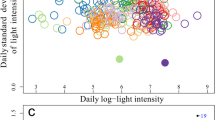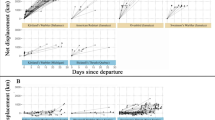Abstract
The nocturnal migration of many passerines starts after sunset and reaches peak intensity during the dark hours of the night. Birds destined for high Arctic breeding grounds encounter a special situation, as they will experience continuous daylight when reaching the high latitudes during the final part of spring migration. How does this affect the pattern of nocturnal migration? We consider three alternative hypotheses; that the period of nocturnal flight activity may become compressed, remain unchanged or become disorganized under Arctic light conditions. We tracked migrating birds by radar north of the Arctic Circle (at Abisko, 68°21′N, 18°49′E, in Swedish Lapland) and show that the pattern during the night, with a migration peak around midnight, persisted even in continuous daylight when the sun remained above the horizon throughout the 24 h of the day. The flight intensity peak under continuous daylight in spring (midnight sun) was very similar to the corresponding peak in autumn, when the migration took place under twilight conditions. The duration of the flight period under continuous daylight in spring lasted 8–10 h and did not seem to be compressed. We hypothesize that the flight period under midnight sun conditions may in fact be more protracted than during short nights, because of release from twilight cues that tend to synchronize initiation and termination of migratory flights. These cues will thus capture and confine the flight period. The results of this provisional study suggest interesting dynamics in timing of nocturnal migratory flights under seasonally and latitudinally changing day length conditions, which will need detailed documentation by future studies of migration intensity at high-latitude sites.


Similar content being viewed by others
References
Edwards S (2010) http://www.sunrisesunset.com/custom.asp. Accessed 04/02 2010
NOAA Solar Calculator (2013) http://www.esrl.noaa.gov/gmd/grad/solcalc/. Accessed 12/8 2013
Åkesson S, Alerstam T, Hedenström A (1996) Flight initiation of nocturnal passerine migrants in relation to celestial orientation conditions at twilight. J Avian Biol 27:95–102
Åkesson S, Walinder G, Karlsson L, Ehnbom S (2001) Reed warbler orientation: initiation of nocturnal migratory flights in relation to visibility of celestial cues at dusk. Anim Behav 61:181–189
Alerstam T (2006) Strategies for the transition to breeding in time-selected bird migration. Ardea 94:347–357
Alerstam T (2009) Flight by night or day? Optimal daily timing of bird migration. J Theor Biol 258:530–536
Bartell PA, Gwinner E (2005) A separate circadian oscillator controls nocturnal migratory restlessness in the songbird Sylvia borin. J Biol Rhythms 20:538–549
Bolshakov CV, Rezvyi SP (1998) Time of nocturnal flight initiation (take-off activity) in the European robin Erithacus rubecula during spring migration: visual observations between sunset and darkness. Avian Ecol Behav 1:37–49
Bolshakov CV, Chernetsov N, Mukhin A, Bulyuk VN, Kosarev V, Ktitorov P, Leoke D, Tsvey A (2007) Time of nocturnal departures in European robins, Erithacus rubecula, in relation to celestial cues, season, stopover duration and fat scores. Anim Behav 74:855–865
Brewster W (1886) Bird migration. Memoirs Nuttall Ornithological Club 1. Nuttall Ornithological Club, Cambridge
Brines M, Gould J (1982) Skylight polarization patterns and animal orientation. J Exp Biol 96:69–91
Brown RGB (1962) The behavior of the Willow Warbler Phylloscopus trochilus in continuous daylight. Ibis 105:63–75
Bulyuk VN, Tsvey A (2006) Timing of nocturnal migratory departures in juvenile European robins (Erithacus rubecula) and endogenous and external factors. J Ornithol 147:298–309
Chernetsov N (2012) Passerine migration. Stopovers and flight. Springer, Berlin
Cochran WW, Mouritsen H, Wikelski M (2004) Migrating songbirds calibrate their magnetic compass daily from twilight cues. Science 304:405–408
Coppack T, Becker SF, Becker PJJ (2008) Circadian flight schedules in night-migrating birds caught on migration. Biol Lett 4:619–622
Daan S, Aschoff J (1975) Circadian rhythms of locomotor activity in captive birds and mammals: their variation with season and latitude. Oecologia 18:269–316
Gwinner E (1996) Circadian and circannual programmes in avian migration. J Exp Biol 199:39–48
Gwinner E, Helm B (2003) Circannual and circadian contributions to the timing of avian migration. In: Berthold P, Gwinner E, Sonnenschein E (eds) Avian migration. Springer, Berlin, pp 81–95
Karlsson H, Bäckman J, Nilsson C, Alerstam T (2010) Exaggerated orientation scatter of nocturnal passerine migrants close to breeding grounds: comparisons between seasons and latitudes. Behav Ecol Sociobiol 64:2021–2031
Kerlinger P, Moore FR (1989) Atmospheric structure and avian migration. In: Power DM (ed) Current ornithology, vol 6. Plenum Press, New York, pp 109–142
Kokko H (1999) Competition for early arrival in migratory birds. J Anim Ecol 68:940–950
Lank DB (1989) Why fly by night? Inferences from tidally-induced migratory departures of sandpipers. J Field Ornithol 60:154–161
Muheim R, Phillips JB, Åkesson S (2006) Polarized light cues underlie compass calibration in migratory songbirds. Science 313:837–839
Nilsson C, Klaassen RHG, Alerstam T (2013) Differences in speed and duration of bird migration between spring and autumn. Am Nat 181:837–845
Pohl H (2000) Circadian control of migratory restlessness and the effects of exogenous melatonin in the brambling, Fringilla montifringilla. Chronobiol Int 17:471–488
Rozenberg GV (1966) Twilight. A study in atmospheric optics. Plenum Press, New York
Schmaljohann H, Korner-Nievergelt F, Naef-Daenzer B, Nagel R, Maggini I, Bulte M, Bairlein F (2013) Stopover optimization in a long-distance migrant: the role of fuel load and nocturnal take-off time in Alaskan northern wheatears (Oenanthe oenanthe). Front Zool 10:26
Siegel S (1956) Nonparametric statistics for the behavioral sciences. McGraw Hill, New York
Silverin B, Gwinner E, Van’t Hof TJ, Schwabl I, Fusani L, Hau M, Helm B (2009) Persistent diel melatonin rhythmicity during the Arctic summer in free-living willow warblers. Horm Behav 56:163–168
Speakman JR, Rydell J, Webb PI, Hayes GC, Hulbert IAR, McDevitt RM (2000) Activity patterns of insectivours bats and birds in northern Scandinavia (69° N), during continuous midsummer daylight. Oikos 88:75–86
Steiger SS, Valcu M, Spoelstra K, Helm B, Wikelski M, Kempenaers B (2013) When the sun never sets: diverse activity rhythms under continuous daylight in free-living Arctic-breeding birds. Proc R Soc B 280:20131016
Strann KB, Bakken V (2004) Hekkefugl Atlas for Troms. Norsk institutt for naturforskning, Tromsö
Strann KB, Helberg M (2004) Unpublished. Dividalen fugelstasjon 10års rapport. In Norwegian
van Oort BEH, Tyler NJC, Gerkema MP, Folkow L, Schytte Blix A, Stokkan KA (2005) Circadian organization in reindeer. Nature 438:1095–1096
Wiltschko R, Wiltschko W (1995) Magnetic orientation in animals. Springer, Heidelberg
Acknowledgments
We would like to thank the staff at Abisko research station. This work was funded by grants from the Royal Physiographic Society in Lund to H.K. and the Swedish Research Council to T.A. The authors are associated with the Center for Animal Movement Research at Lund University (Linnaeus Grant 349-2007-8690).
Author information
Authors and Affiliations
Corresponding author
Rights and permissions
About this article
Cite this article
Nilsson, C., Bäckman, J., Karlsson, H. et al. Timing of nocturnal passerine migration in Arctic light conditions. Polar Biol 38, 1453–1459 (2015). https://doi.org/10.1007/s00300-015-1708-x
Received:
Revised:
Accepted:
Published:
Issue Date:
DOI: https://doi.org/10.1007/s00300-015-1708-x




